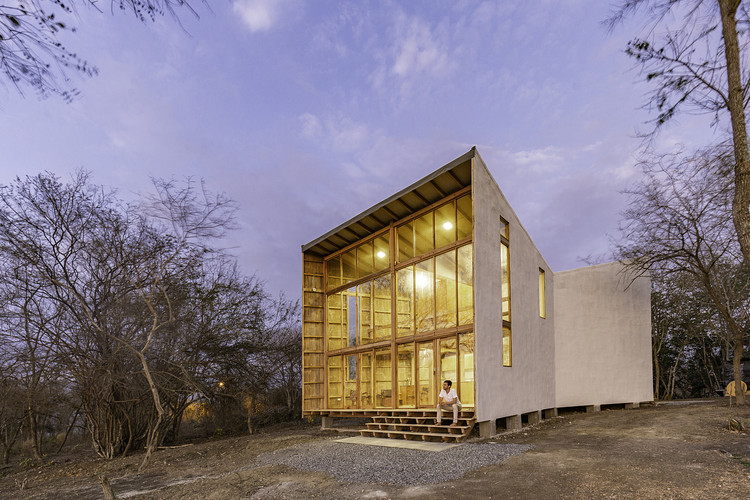Jodie’s House Casey Brown Architects
2016-03-18 17:00
© Greg Haremza
格雷格·哈雷姆萨


架构师提供的文本描述。位于悉尼港的朱迪之家位于一个陡峭的斜坡上,向东北方向俯瞰海滩和远处的海水。由于地形的原因,这座建筑成了一系列的亭子。它们错综复杂地连在一起,从遗址的顶端向岸边串起。这些层次之间的联系既复杂又微妙,给人一种旅行和发现的感觉,因为你在整个房子里移动。
Text description provided by the architects. Jodie’s House on Sydney Harbour is situated on a dramatic steeply sloping site with north-easterly views over the beach and the water beyond. The topography resulted in the building being articulated as a series of pavilions. Intricately linked they cascade from the top of the site towards the shore. Connections between these levels are both complex and subtle, giving both a sense of journey and discovery as you move throughout the house.
© Greg Haremza
格雷格·哈雷姆萨


该遗址的地形也启发了房子本身的重要性,与近白色的异形混凝土形成鲜明对比的是,墙面上露出了凿成的砂岩。额外的对比和温暖是通过回收的斑点树胶天花板,地板和红棕色的铜屋顶,这将逐渐成熟为丰富的蓝绿色。
The topography of the site also inspired the materiality of the house itself, with cutaways revealing walls of hewn sandstone, contrasting with near-white off-form concrete. Additional contrast and warmth is introduced through the recycled spotted gum ceilings and flooring and reddish brown tones of the copper roofing, which in time will mature to a rich blue-green.


当你从上面的亭子俯瞰海滩时,下面的亭子的屋顶景观就成了景观的一部分。这些表面被视为雕塑,精致的铜被扭曲成翻转的平面,充当屋顶灯和牧师窗口,直到更低的水平。有了这个连续的更高层次的窗户,家庭的照明和通风需求得到了很好的满足,同时又不损害邻近邻居的视觉隐私。
As you look down from the upper pavilions towards the beach the roofscape of the lower pavillions becomes a part of the view. These surfaces have been treated as a sculpture, the delicate copper has been twisted into upturned planes acting as roof lights and clerestory windows to the lower levels. With this continuous band of higher level windows the home’s light and ventilation needs are well provided for, while not compromising visual privacy from the adjacent neighbours.
© Stuart Scott
(斯图尔特·斯科特)


在街上,房子既朴素又大方。入口是通过一座高架桥开放到一个北面的观景台,这个平台展现了海滩和灌木丛。一条蜿蜒而又匀称的楼梯一直延伸到房子的主要居住和聚集区。家庭居住空间集中在北面甲板和受保护的南方庭院周围。甲板和庭院通过室内空间提供光线、通风和景观,并促进从内到外的无缝过渡。
On the street, the house is both modest and generous. Entry is via an elevated bridge that opens onto a north facing viewing platform which presents the beach and bushland beyond. A winding generously-proportioned stair descends to the principal living and gathering area of the house. The family living spaces are focused around both a north facing deck and a protected southern courtyard. The deck and courtyard provide light, ventilation and views through the interior spaces and foster seamless transitions from inside to out.
© Stuart Scott
(斯图尔特·斯科特)


主卧室套房只能通过私人书房区的一个隐藏楼梯进入。在最上层隐秘的,它提供了一种逃避和退却的感觉。在最低层,三间卧室为这对夫妇的三胞胎提供了充足的空间,以及一个媒体室和儿童学习区,后者通往后花园。
The master bedroom suite is accessible only via a hidden stair from the private study area. Secreted away on the uppermost level, it offers a sense of escape and retreat. On the lowest level, three bedrooms provide ample space for the couple’s triplet children, as well as a media room and children’s study area, which opens onto the back garden.
© Greg Haremza
格雷格·哈雷姆萨


这些相互连接的亭子给了大家庭一些隐私。而开放的厨房,餐厅和生活区提供了一个大的聚会空间,作为一个焦点的家庭聚集在一起。阶梯交错的设计是一系列庭院空隙,允许光线和视野渗透到每一个空间,以及提供保护空间,从炎热的东北夏季风。
These interconnected pavilions give privacy to the large family. While the open kitchen, dining and living area provide a large gathering space that serves as a focal point for the family to come together. The stepped and staggered design is articulated as a series of courtyard voids, allowing for light and views to penetrate into every space, as well as provide protected spaces from the hot north-easterly summer winds.
© Stuart Scott
(斯图尔特·斯科特)


这座房子是为一个大家庭而设计的,它的特点是平静而优雅,有着坚固而美丽的天然材料,赋予了永恒的品质。
The house was designed for a large family, and has achieved a character that is calm and refined, with robust and beautiful natural materials that give a timeless quality.
© Greg Haremza
格雷格·哈雷姆萨




















































Architects Casey Brown Architects
Location Sydney, Australia
Category Houses
Design Architect Robert Brown
Project Architect Tom Monahan
Project Year 2014
Photographs Stuart Scott, Greg Haremza































